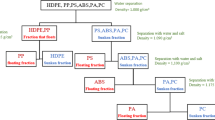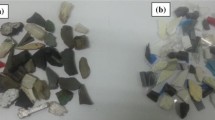Abstract
This study covers the triboelectrostatic separation of Polyvinylchloride (PVC) materials from mixed plastics such as polyethylene terephthalate (PET), polyethylene (PE), polypropylene (PP), and polystyrene (PS). The PVC material generates hazardous hydrogen chloride gas resulting from the combustion in the incinerators. The laboratory scale triboelectrostatic separation system consists of a fluidized-bed tribocharger, a separation chamber, a collection chamber and a controller. Negative and positive surface charges can be imparted to the PVC and PET particles, respectively, due to the difference of triboelectric charging series between the particles in the fluidized-bed tribocharger. They can be separated by passing through an external electric field. A highly concentrated PVC (91.9%) can be recovered with a yield of about 96.1% from the mixture of PVC and PET materials in a single stage of processing. For the removal of PVC from the two-component mixed plastics such as PVC/PET, PVC/PP, PVC/PE or PVC/PS, separation results show the recovery of 96–99% with the pure extract content in excess of 90%. The triboelectrostatic separation system using the fluidized-bed tribocharger shows the potential to be an effective method for removing PVC from mixed plastics for waste plastic recycling.
Similar content being viewed by others
References
Brandrup, J., Bittner, M. and Menges, G., “Recycling and Recovery of Plastics,” Hanser Publishers (1996).
Bruck, R., “Chemische Konstitution und elektrostatische Eigenschaften von Polymeren,”Kunststoffe,71(4), 234 (1981).
Davies, D. K., “Static Electrification,”Inst. Phys. Conf. Series.,4, 29 (1967).
Greason, W. D. and Inculet, I. L, “Insulator Work Function Determination from Contact Charging with Metals,”IEEE-IAS Annual Conf. Proceedings,1,428 (1975).
Gupta, R., Cidaspow, D. and Wasan, D. T., “Electrostatic Separation of Powder Mixtures Based on the Work Functions of its Constituents,”Powder Technology,75, 79 (1993).
Harper, W R, “Contact and Frictional Electrification,” Clarendon Press, Oxford (1967).
Inculet, I. I., Castle, G.S.P. and Brown, J.D., “Tribo-Electrification System for Electrostatic Separation of Plastics,”IEEE-IAS Annual Conference Proceedings,1, 1397 (1994).
Kang, Y, Woo, K. I, Ko, M. H., Cho, Y J. and Kim, S. D., “Particle Flow Behavior in Three-Phase Fluidized Beds,”Korean J. Chem. Eng.,16, 784 (1999).
Kim, J. M., Han, G. Y. and Yi, C. K., “The Characteristics of Particle Flow in the Overflow and Underflow Standpipe of Fluidized Beds,”Korean J. Chem. Eng.,17, 273 (2000).
Lee, S. H., Lee, D. H. and Kim, S. D., “Slug Characteristics of Polymer Particles in a Fluidized Bed with Different Distributors,”Korean J. Chem. Eng.,18,387 (2001).
Lu, W. M., Ju, S. P., Tung, K. L. and Lu, Y C, “Stability Analysis of Perforated Type Single Stage Suspension Fluidized Bed Without Downcomer”Korean J. Chem. Eng.,16, 810 (1999).
Matsushita, Y, Mori, N. and Sometani, T, “Electrostatic Separation of Plastics by Friction Mixer with Rotary Blades,”Electrical Engineering in Japan,127(3), 33 (1999).
Pearse, M. J. and Hickey, T. I, “The Separation of Mixed Plastics Using a Dry, Triboelectric Technique,”Resource Recovery and Conservation,3,179(1978).
Takeshita, T, Atsumi, K, Iwasaki, Y. and Harada, T, “The Triboelectric Separation for Plastic Sheets,”J. Soc. Powder Technol, Japan,35, 106 (1998).
Yanar, D. K. and Kwetkus, B. A., “Electrostatic Separation of Polymer Powders,”Journal of Electrostatics,35, 257 (1995).
Author information
Authors and Affiliations
Corresponding author
Rights and permissions
About this article
Cite this article
Lee, JK., Shin, JH. Triboelectrostatic separation of pvc materials from mixed plastics for waste plastic recycling. Korean J. Chem. Eng. 19, 267–272 (2002). https://doi.org/10.1007/BF02698412
Received:
Accepted:
Issue Date:
DOI: https://doi.org/10.1007/BF02698412




